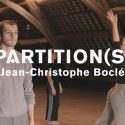The Partition(s) subtitle, Du décollement des sentiments et des affects (“On dis-attaching feelings and affects”) I think must mean something like “letting go” or even “purifying”. “Must” because it’s hard to describe the crystalline sensibilityJean-Christophe Boclé achieves for every element of and in this remarkable piece for four dancers – two men, two women – a double bass player at upper left stage and a cello player at lower right stage.
Boclé writes in his notes of an intention to let performers call up and show the primal movements that support the performance; he actually manages to do it.
On stage, Boclé sharpens ears with single sounds plucked from the smooth surface of the double bass’ thick strings. He choreographs movement that, at first, at least, has the feel of Liz Santoro’s neurologically-informed transistor-board promenades in such pieces as Mutual Information or Maps. As with Santoro, Boclé’s opening movements conjure the image of synapses, evoke the air of a mindful brain at rest and aware.
Then the movements shape together. At first, as with Santoro, they are intervals, crossings, parallels, angles. Then, symmetries. With composer Pierre Godard’s sound tickling and teasing, Santoro likes to build off these symmetries, to take an audience into fascination.
Boclé’s Partition(s) uses the psychic potential built up in forming the symmetries for a breakout from fascination to something like contemplative attention. I’m not sure how or at what moment, but as with Anne Teresa De Keersmaeker’s choreography for Steve Reich – Violin Fase, the regularity and precision of movement seem to go slightly awry, collapse away from themselves – a quark sneezes? The spectator is aware of a change in psychic tone. After the change another sensibility reigns. The symmetries are understood as fractals.
On stage, in Partition(s), the spark for this change of sensibility seems to be within the potential of a sudden note from the double bass.
The new sensibility twists sound to music and music into physical and metaphysical phenomena and uncountable cross-pollinations. The sensibility around the flow of thoughts, ideas, feelings and emotions makes them all seem to mix and match more easily.
On stage, persons and couples alternate from deep contemplation to attentive lightness. Each of all – and I was somehow able to keep track of all this during the experience – each of all play with, move through, go around, leap over, spin under, fall into the expanding times, spaces, presences and imaginings. With that movement the spectator has the time to experience beyond words: movement is persons and persons are movement and times, spaces and presences, imaginings, incarnated liberty.
I can’t be more specific and flat-voiced than this: These are performers dancing around and about J.S. Bach. This is an experience of what complexity looks, feels, tastes, tastes and hears like.
Put Partition(s) on your bucket list.
I saw Partition(s): Du décollement des sentiments et des affects on 26 January 2023 at Carreau du Temple as part of the 2023 Festival Faits d’Hiver dance-performance program. Performers were Iris Brocchini, Marion Jousseaume, Gaspard Charon and Remi Gérard. Sound base was Johan Sebastien Bach Cello Suites IV and V with Elena Andreyev on cello and Gildas Boclé on double bass. For remarks on Faits d’Hiver programming see Santé, Bonheur! Joy! Imagination! Discernment! Thoughts on some upcoming dance and performance [By Tracy Danison].
Go to Source
Author: Paul Tracy DANISON
